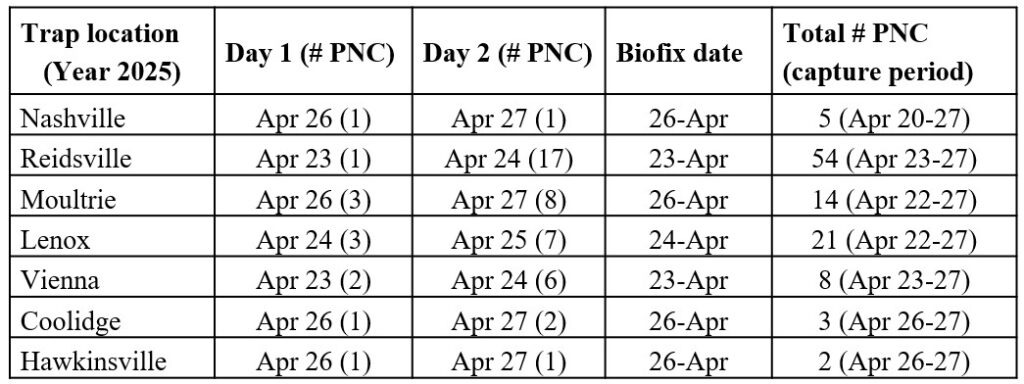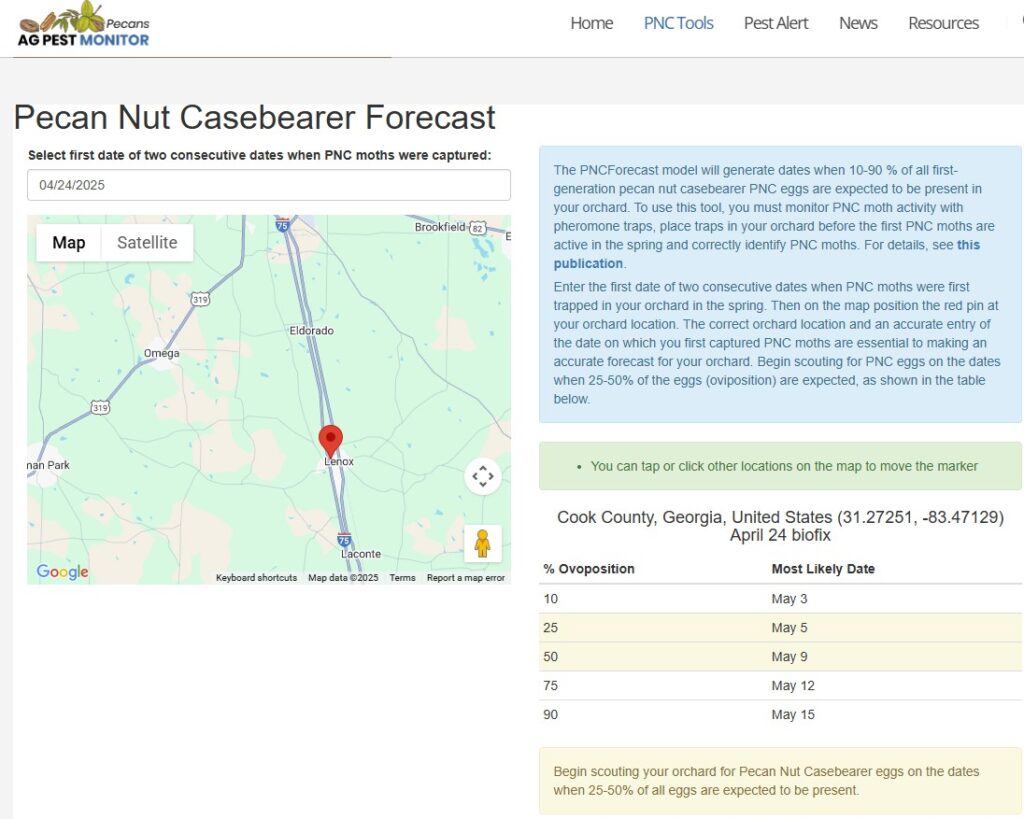The warm temperatures over the last couple of weeks have certainly had an impact on insects, particularly reducing the time it takes for them to transition from one life stage to another. Our focus at this time of the year is pecan nut casebearer (PNC), which overwinters as larvae and becomes adult moths with the onset of spring. These moths are going to lay eggs, which will eventually hatch and try to feed on the young nutlets of pecan trees. The strategy to target these young larvae before they enter the nutlet involves timing an insecticide application by backtracking when female PNC moths are available in the orchard. To detect the presence of PNC moths, we put out “traps” baited with pheromone lures. Once these traps capture the moths for two consecutive days (also referred to as biofix date), it indicates that the moths are actively emerging, and the females are expected to start laying eggs near the nutlets. Females live for about a week, but they lay between 50-150 eggs during that time. These eggs will hatch after 4-5 days and the young larvae/caterpillars will feed outside the nutlet before they enter inside after 2-3 days. The feeding results in black frass, and often, nutlets are tangled with silk (Figure 1). Eventually, the nutlets in the cluster will be damaged and drop.

Figure 1. Pecan nut casbearer adult moth (left), eggs (center) and infested nutlets with frass and silk webs on the cluster
Understanding the biology of this insect, the most vulnerable stage of the insect is the young larvae, which feed outside the nutlet for 2-3 days after hatching. Once they enter the nutlet, they are less exposed to insecticide being applied, and therefore, the efficiency of the products may not be realized as expected. How do we determine when to make an insecticide application to maximize the benefits? To help us with this decision, a PNC forecast model was developed based on historical data for this insect. We can now utilize this platform to predict (https://pecan.agpestmonitor.org/ipmtoolbox/forecast/) when to expect the egg laying and moth emergence. The PNC traps placed this year in different locations in South Georgia by UGA county agents and collaborators with FMC Corporation indicated that we reached biofix sometime last week (Figure 2).

Figure 2. Installing “smart trap” provided by FMC to monitor PNC in Colquitt County (left), a high number of PNC moths captured on a trap in Reidsville, GA in 2025 (right)
Please find the biofix date for some of the locations where PNC traps are currently placed (Table 1). Although it would be desirable to have traps in most locations, based on the trap information from current locations, this approach can also be applied to other South Georgia locations. Growers can use this timeline to make applications for PNC. Consider that due to the warm weather in April this year, the PNC activity is a bit early (by 3-4 days) compared to last year.

To give an example of how to use this trap information to make insecticide application timing- in Cook County (Lenox), we met biofix on April 24th, and when we put that information on the “forecast model,” we saw that 50% of the egg laying is expected to on May 9th (Figure 3). If you consider another 4-5 days for hatching these eggs, then it would be around May 14th-15th when one should expect to see damage from the larvae. Therefore, making an insecticide application sometime between May 9th and May 14th should give optimum protection from any damage by PNC.

Figure 3. Expected date of egg laying and decision making to time insecticide application based on the PNC forecast tool
In terms of products, growers most commonly use methoxyfenozide, which is present in several commercial products, including Intrepid, Intrepid Edge, Zylo, and Troubadour. Please see the individual label for the rate and specific instructions. In general, methoxyfenozide has 7-10 days of residual activity, and it is highly effective against caterpillar pests. Another caterpillar-specific product is Rynaxypyr®, which is an active ingredient found in several commercial products (such as Vantacor or Coragen) and can also be used for PNC management.
